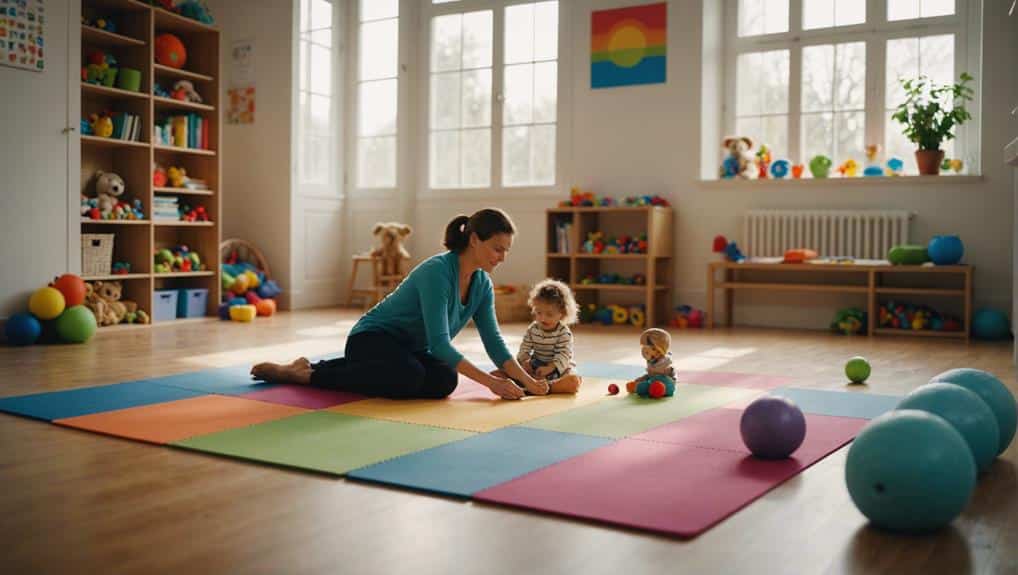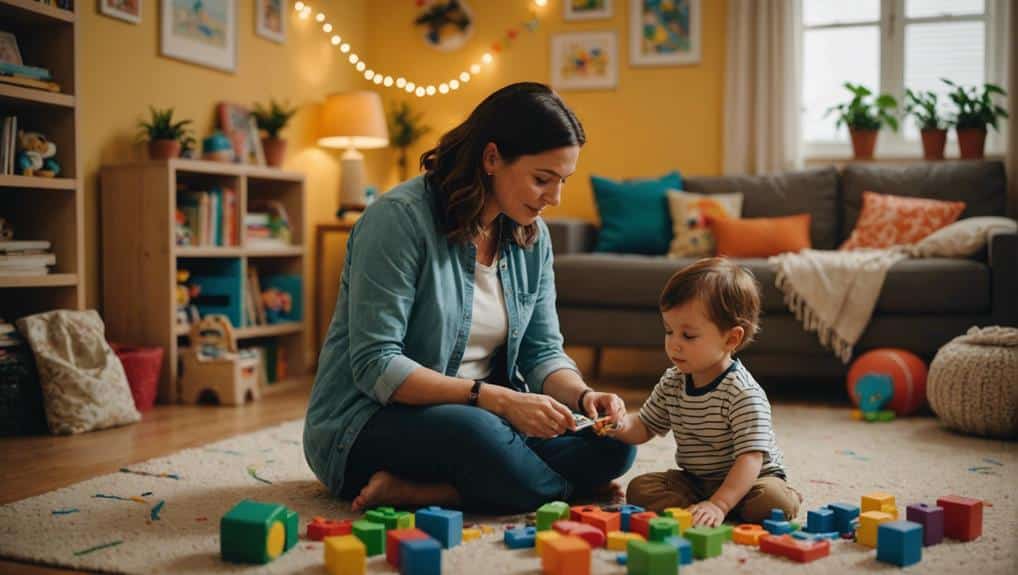Nurture Your Child by engaging their visual development through high-contrast objects and smooth tracking activities. Encourage rolling techniques to enhance motor skills and explore diverse toys for cognitive development to promote sensory exploration and creativity.
These activities will empower your child’s potential and support their overall growth. Nurture Your Child by supporting proper posture to guarantee healthy musculoskeletal growth and balance. Guide them through physical milestones like crawling and walking in a supportive environment, celebrating each achievement. By incorporating evidence-based strategies, including DIRFloortime, you can foster a nurturing environment that encourages your child to thrive. Dive deeper to discover more tips for your child’s development.
Key Takeaways
- Use high-contrast toys to stimulate visual development and enhance eye coordination.
- Practice Tummy Time daily to build core strength and motor skills for sitting and crawling.
- Introduce diverse, sensory-rich toys to nurture cognitive development and understanding of textures, shapes, and colors.
- Ensure proper posture support to promote musculoskeletal health and prevent future issues.
- Create a supportive home environment with soft mats and obstacle courses to encourage movement and motor skills development.
Visual Tracking Activities
Engaging your child in visual tracking activities can significantly enhance their eye coordination and focus. These activities are fun and essential in developing an important skill set to help your child navigate their world more quickly and confidently. Visual tracking is vital because it allows your child to follow objects and people in their environment, a foundational ability for tasks like reading and playing.
One effective way to stimulate visual tracking is to use high-contrast colors, such as black and white. These colors are especially engaging for infants, capturing their attention and helping to develop their visual processing skills. You can start by slowly moving a black-and-white object in front of your child’s eyes, encouraging them to follow it. This simple exercise can significantly affect their ability to track motion.
Additionally, using slow, smooth movements when presenting objects helps your child to focus and follow the object more effectively. By incorporating these visual tracking activities into your daily routine, you’re helping your child’s eye coordination and fostering a sense of belonging by actively participating in their developmental journey.
Effective Tummy Time
When starting Tummy Time, aim for short sessions multiple times daily and gradually increase the duration as your baby grows. Use engaging tools like high-contrast toys or mirrors to keep your baby interested and enhance their visual development. Always ensure you’re using a safe, comfortable surface and offer gentle support to make the experience enjoyable for both of you.
Ideal Time Duration
Practicing Tummy Time for 3-5 minutes several times daily is essential to support your infant’s development. Starting from birth, these short, frequent sessions can help prevent flat head syndrome and promote crucial motor skills. It’s essential to ensure your baby is on a supportive surface and gradually extend the duration as they grow stronger. Next time you place your baby on their tummy, watch how they lift their head and strengthen their neck, shoulders, and core muscles.
I’m going to emphasize that consistency is critical. Consistent Tummy Time sessions improve head control, visual tracking, and overall physical development. Don’t worry if your baby fusses initially; this is normal. Encourage them, and soon enough, they’ll enjoy this vital exercise.
Engaging Baby Tools
You might try gentle movements during Tummy Time sessions to support physiological flexion. This can help your baby feel more comfortable and natural in the prone position. Another effective tool is a rolled-up sheet placed under your baby’s armpits. This provides additional support and helps them maintain a proper posture, making the experience more pleasant and productive.
Tummy Time is essential not just for muscle strengthening but also for environmental exposure. It helps your baby explore their surroundings from a different perspective, strengthening their shoulder muscles and promoting proper head lifting alignment. These physical benefits are essential for their overall development.
Incorporating these tools into your Tummy Time routine can significantly enhance its effectiveness, ensuring your baby gets the most out of these critical developmental moments. Remember, your engagement and encouragement are key in making Tummy Time a positive experience for your child.
Safe Surface Choices
Selecting the appropriate surface for Tummy Time is essential for your baby’s safety and development. You’ll want to use a firm, flat surface like the floor, which provides the best support and reduces the risk of suffocation. Soft surfaces like beds or sofas might seem comfortable, but they can pose significant dangers, including suffocation hazards.
To create the perfect environment, choose a clean, clutter-free area. This ensures your baby has enough space to move and explore without any risk of injury. When you place your baby on their stomach, ensure the area is free from small objects or toys that could be a choking hazard.
It’s essential to position your baby on its stomach for short periods multiple times daily. This helps build the neck, shoulder, and arm muscles necessary for development. Always supervise your baby closely during Tummy Time to prevent accidents and ensure safety. Staying nearby offers protection and creates a sense of security and belonging for your little one.
Rolling Techniques

When you encourage your baby to roll, you’re building their core strength and enhancing their motor skills. Rolling helps them develop the muscles they need for future milestones like sitting and crawling. By offering gentle support and creating motivating environments, you’re setting the stage for their physical growth and confidence.
Building Core Strength
Assisting your infant in practicing rolling techniques is an essential step in building their core strength and enhancing their coordination. Rolling exercises not only strengthen the muscles needed for sitting, crawling, and eventually walking, but they also help prevent head preference and promote balanced muscle development. By encouraging these movements, you’re setting up a foundation for your child’s future physical abilities.
To help you get started, here’s a simple guide to rolling techniques:
| Technique | Benefits | Tips for Parents |
|---|---|---|
| Tummy to Back | Strengthens neck and back muscles | Use a toy to guide their head movement |
| Back to Tummy | Engages core and arm muscles | Gently assist their hips and legs |
| Side Rolling | Promotes lateral muscle strength | Encourage reaching for toys on the side |
| Assisted Rolling | Develops overall coordination | Provide gentle support under the shoulders |
| Playful Rolling | Enhances engagement and fun | Use songs and playful interaction |
Enhancing Motor Skills
Building on core strength and enhancing motor skills through rolling techniques guarantees your infant develops symmetrical muscle growth and coordination. Rolling from back to tummy and vice versa is essential for infants aged three to six months. This activity strengthens their neck, back, and core muscles, laying a solid foundation for future motor skills.
To help your baby master rolling, create a safe and supportive environment where they can explore and practice. Soft mats or blankets on the floor provide a cushioned surface that encourages movement without the risk of injury. Place exciting toys out of reach to motivate your baby to roll towards them, promoting curiosity and physical development.
Practicing rolling in both directions improves coordination and balance. Gently guide your baby, offering encouragement and support as they attempt this new skill. Consistent practice is critical; the more opportunities your baby has to roll, the quicker they’ll master it and move on to more complex movements.
Toy Exploration
Exploring toys with your child is an essential activity that nurtures their understanding of textures, shapes, colors, and cause-and-effect relationships. Toy exploration can significantly contribute to your child’s cognitive and sensory development. To make the most of this activity, consider these evidence-based strategies:
- Choose Diverse Toys: Opt for toys that stimulate different senses, such as tactile blocks, musical instruments, and brightly colored puzzles. These can enhance your child’s sensory experiences and cognitive growth.
- Rotate Toys Regularly: Rotating toys prevents boredom and sparks curiosity. This keeps your child engaged and encourages them to explore new ways of playing and learning.
- Promote Motor Skills: Select toys that aid in developing both fine and gross motor skills. Stacking rings, balls, and building blocks can improve coordination and physical development.
- Engage Together: Explore toys with your child. This strengthens the parent-child bond and provides valuable opportunities for learning and growth.
Posture Support

Proper posture support for your child during developmental activities is essential for their musculoskeletal health and overall physical development. It’s crucial to guarantee your child maintains correct posture alignment, which can be facilitated using props like rolled sheets or cushions. These simple tools can make a significant difference, helping prevent future musculoskeletal issues and promoting healthy growth.
Encouraging good posture early on safeguards your child’s physical health and boosts their balance and coordination. These foundational skills are critical for their ability to engage in more complex movements as they grow. For example, providing adequate support can enhance your child’s engagement and curiosity during activities like Tummy Time or while sitting, making exploration more enjoyable and effective.
Proper posture support is also essential for strengthening core muscles, which are crucial for overall motor development. When your child’s core is strong, they’re more likely to develop better movement skills and overall physical confidence. By prioritizing posture, you’re addressing immediate physical needs and setting your child up for a lifetime of healthy physical activity and well-being. This proactive approach can help your child feel more confident and included in their developmental journey.
Movement Progression
As your child’s posture is supported, paying attention to their movement progression is equally important to enhance their physical development further. Understanding movement progression is vital for unleashing your child’s physical potential during their developmental stages. Facilitating proper movement patterns can significantly improve their motor skills and coordination.
To support your child’s movement progression, consider the following steps:
- Guide them through milestones: Help your child achieve vital developmental milestones such as rolling, sitting, crawling, and walking. These activities lay the foundation for more complex movements later on.
- Encourage movement exploration: Allow your child to explore various types of movement. This will build their strength and balance and enhance their spatial awareness.
- Create a supportive environment: Make sure your home is safe and conducive to movement. Soft mats, obstacle courses, and open spaces can significantly affect your child’s confidence in movement.
- Boost their confidence: Celebrate small victories to build their self-esteem. A confident child is likelier to take risks and try new things, which is essential for physical development.
Frequently Asked Questions
How to Unlock Your Child’s Potential?
To unleash your child’s potential, encourage them to explore diverse activities, support their passions, and provide a nurturing environment. Avoid pressuring them, and show unwavering love and encouragement to help them thrive and develop discipline.
How Do I Nurture Your Child to Reach Their Full Potential?
To help your child reach their full potential, encourage them to explore diverse interests, provide unwavering support, balance freedom with discipline, invest in their talents, and consistently express love and encouragement. Your support fosters their growth.
How Are You Enabling Your Child to Reach Their Potential?
You empower your child by encouraging their interests, providing heartfelt financial support, and balancing freedom and discipline. Your dedication and love create a nurturing environment that helps them explore and achieve their dreams.
How to Nurture Your Child’s Creativity?
Did you know 85% of a child’s brain development happens before age 5? Encourage open-ended play, offer diverse art supplies, and praise their efforts. These steps will help your child feel valued and boost their creativity.
Conclusion
Unlocking your child’s potential isn’t a mystery; it’s a journey. You lay the foundation by providing children with a wide range of activities to support their learning and development. Incorporate hands-on and fun activities to enhance their cognitive and motor skills. Encourage daily routine and consistent positive reinforcement to build emotional intelligence and problem-solving abilities. Collaborative learning and supportive interactions help children develop strong relationships and communication skills.
To support their emotional and physical health, it’s crucial to praise effort and provide opportunities for children to express a wide range of emotions. Picture books and repetition-based learning can enhance their language and executive function skills. Additionally, creating a supportive environment at home, in child care centers, and in community activities is essential for their healthy development.
Remember, every small step you take today shapes their tomorrow. It’s important to set achievable goals and provide practical strategies to empower children in their learning journey. Embrace these strategies and watch them flourish. Your commitment and nurturing parenting style make all the difference in their emotional and academic growth.


Recent Comments